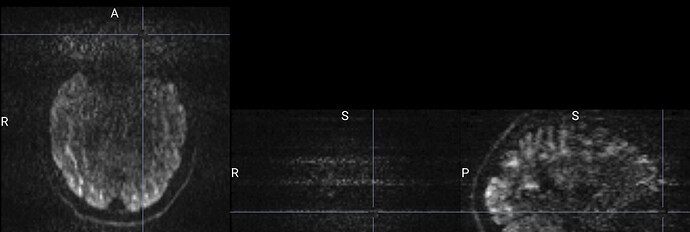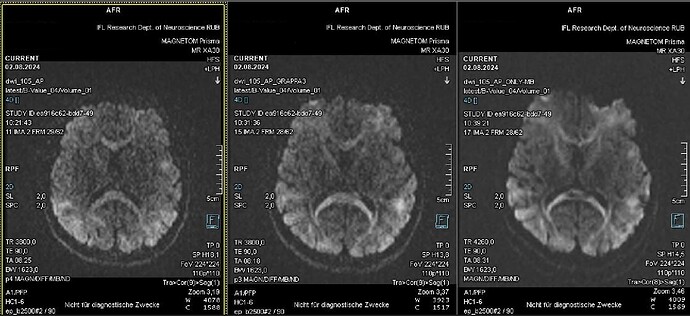Dear experts,
for a certain DWI sequence we get an artifact that looks like a zipper in coronal and sagittal view:
However, if one looks at the slice of the artifact, in the transverse image it looks like the signal is modulated in AP-direction:
The artifact appears in every image (b0 to b2500), but is easier to spot at higher b values.
I put a sample dataset here, including the json:
https://www.dropbox.com/scl/fo/o3vh9hmcgskrolnlcj3zs/AFEYujqRVGxFieGHmXJRVC0?rlkey=nnlzb08b5iun4mhrmde2oqwmk&st=rdflkwm3&dl=0
Has anyone ever seen something like this?
Thank you!
Marco
I think there are experts with more knowledge than me. I am not sure the level of artifacts is beyond what is expected. High b-values have low SNR.
There is a lot of acceleration used. I recognize the partial Fourier does reduce the PSF and allows a shorter TE, but it does prevent you from using some effective post processing. Therefore, you might want to use the ful Fourier with the x4 GRAPPA providing the relatively short TE. I do note there is a conflict between what the comments suggest (multiband=2 and GRAPPA = 3) and what dcm2niix detects (multiband=2 and GRAPPA = 4). It might be worth setting the GRAPPA to 3 as suggested in the comments to reduce aliasing. You will have a longer TE and more spatial distortion, but tools like Eddy and TOPUP can deal with the latter and the better sampling will combat the former.
"ImageComments": "Unaliased MB2/PE3",
"PartialFourier": 0.75,
"MultibandAccelerationFactor": 2,
"ParallelReductionFactorInPlane": 4,
Hey Chris,
thank you for your input on this!
Reducing the GRAPPA factor from 4 (left) to 3 (middle) to 1 (right) does improve the problem:
All were measured with MB factor of 2 - so it seems combining different accelerations should always be double checked.
Best,
Marco


